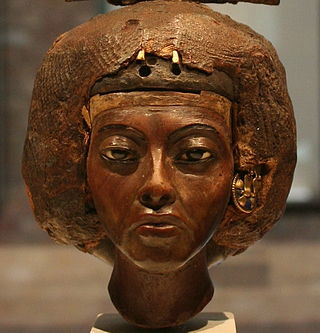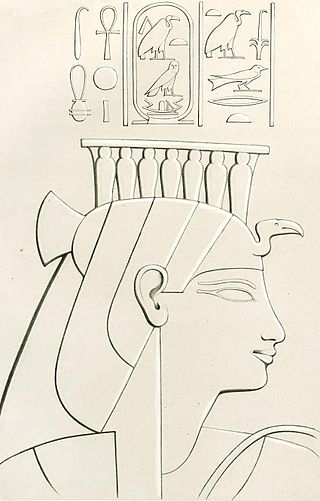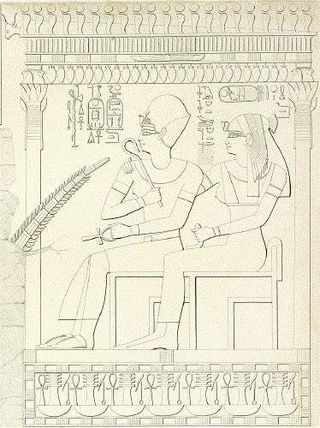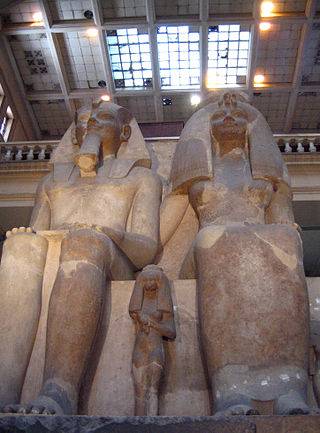The Painting of Lady Tjepu is a fragment from a large fresco from Tomb 181 in Thebes (Luxor). It dates to the 18th Dynasty reign of Pharaoh Amenhotep III.
The painting depicts an elegantly dressed woman with much jewelry. She holds her head upright and faces straight ahead, her right arm is bent and held up, her left is held at hip height. In her left hand she holds a menat. Her white garment is slightly translucent and in many places her body can be seen underneath it. Her wig is finely worked with a crown of flowers on top. A small head cone on top of her head is made of grease or fat. As a symbol it indicates Tjepu's membership in the upper layer of society. Her name and role as "Lady of the House" are inscribed behind her head.
The complete image showed Tjepu behind Nebamun, her son. Nebamun shared the grave with another sculptor, Ipuki. The depiction of the mother in this position is unusual, as most graves depict the owner's wife in this location. Perhaps this diversion from usual practice indicates a special connection between Nebamun and Tjepu. The space was probably free for the mother because Nebamun married the widow of Ipuki (and made use of his grave) and she was already depicted with Ipuki. Son and mother stand before a shrine, where they bring an offering for the Beautiful Festival of the Valley in honour of the deity Amun. In accordance with tradition, Tjepu is not shown at her real age, but in an idealised, youthful form.
The image is dated to the late 18th Dynasty, in the reign of Pharaoh Amenhotep III (1390–1353 BC). The clothing of Tjepu conforms to the fashion of this time. It was painted on the plaster of the walls of the tomb. The image entered the Brooklyn Museum in 1916 as part of the collection of Charles Edwin Wilbour, where it remains a key piece of the ancient Egyptian collection to this day (inventory number 65.197). Thus, it has been the title image of catalogues of the collection since 1999 and also appeared on the title page of the catalogue edited for the travelling exhibition of pieces from the Brooklyn Museum in Berlin in 1976.

Hatshepsut was the fifth Pharaoh of the Eighteenth Dynasty of Egypt, ruling from c. 1478 or 1479 BC until her death in 1458 BC.

Neferneferuaten Nefertiti was a queen of the 18th Dynasty of Ancient Egypt, the great royal wife of Pharaoh Akhenaten. Nefertiti and her husband were known for their radical overhaul of state religious policy, in which they promoted the earliest known form of monotheism, Atenism, centered on the sun disc and its direct connection to the royal household. With her husband, she reigned at what was arguably the wealthiest period of ancient Egyptian history. Some scholars believe that Nefertiti ruled briefly as Neferneferuaten after her husband's death and before the ascension of Tutankhamun, although this identification is a matter of ongoing debate. If Nefertiti did rule as Pharaoh, her reign was marked by the fall of Amarna and relocation of the capital back to the traditional city of Thebes.

Mut, also known as Maut and Mout, was a mother goddess worshipped in ancient Egypt and the Kingdom of Kush in present-day North Sudan. In Meroitic, her name was pronounced mata): 𐦨𐦴. Her name means mother in the ancient Egyptian language. Mut had many different aspects and attributes that changed and evolved greatly over the thousands of years of ancient Egyptian culture.

Meretseger was a Theban cobra-goddess in ancient Egyptian religion, in charge with guarding and protecting the vast Theban Necropolis — on the west bank of the Nile, in front of Thebes — and especially the heavily guarded Valley of the Kings. Her cult was typical of the New Kingdom of Egypt.

Tiye was the Great Royal Wife of the Egyptian pharaoh Amenhotep III, mother of pharaoh Akhenaten and grandmother of pharaoh Tutankhamun; her parents were Yuya and Thuya. In 2010, DNA analysis confirmed her as the mummy known as "The Elder Lady" found in the tomb of Amenhotep II (KV35) in 1898.

Amenhotep III, also known as Amenhotep the Magnificent or Amenhotep the Great, was the ninth pharaoh of the Eighteenth Dynasty. According to different authors, he ruled Egypt from June 1386 to 1349 BC, or from June 1388 BC to December 1351 BC/1350 BC, after his father Thutmose IV died. Amenhotep was Thutmose's son by a minor wife, Mutemwiya.

Kiya was one of the wives of the Egyptian Pharaoh Akhenaten. Little is known about her, and her actions and roles are poorly documented in the historical record, in contrast to those of Akhenaten's ‘Great royal wife’, Nefertiti. Her unusual name suggests that she may originally have been a Mitanni princess. Surviving evidence demonstrates that Kiya was an important figure at Akhenaten's court during the middle years of his reign, when she had a daughter with him. She disappears from history a few years before her royal husband's death. In previous years, she was thought to be mother of Tutankhamun, but recent DNA evidence suggests this is unlikely.

Ahmose-Nefertari was the first Great Royal Wife of the 18th Dynasty of Ancient Egypt. She was a daughter of Seqenenre Tao and Ahhotep I, and royal sister and wife to Ahmose I. Her son Amenhotep I became pharaoh and she may have served as his regent when he was young. Ahmose-Nefertari was deified after her death.

Mutemwiya was a minor wife of the Eighteenth Dynasty pharaoh Thutmose IV, and the mother of Pharaoh Amenhotep III. Mutemwiya's name means "Mut in the divine barque". While unconfirmed, it has been suggested that she acted as regent during the minority of her son Amenhotep III.
The ancient Egyptian official named Menna carried a number of titles associated with the agricultural estates of the temple of Karnak and the king. Information about Menna comes primarily from his richly decorated tomb in the necropolis of Sheikh Abd al-Qurna at Thebes. Though his tomb has traditionally been dated to the reign of Thutmose IV, stylistic analysis of the decoration places the majority of construction and decoration of the tomb to the reign of Amenhotep III.

Tiaa or Tia'a was an ancient Egyptian queen consort during the Eighteenth Dynasty of Egypt. She was a "faceless concubine" during the time of Amenhotep II who withheld from her the title Great Royal Wife, but when her son Thutmose IV became pharaoh, he performed a revision of her status and gave her that title.

The Department of Ancient Egypt is a department forming an historic part of the British Museum, with Its more than 100,000 pieces making it the largest and most comprehensive collection of Egyptian antiquities outside the Egyptian Museum in Cairo.

The lost Tomb of Nebamun was an ancient Egyptian tomb from the Eighteenth Dynasty located in the Theban Necropolis located on the west bank of the Nile at Thebes in Egypt. The tomb was the source of a number of famous decorated tomb scenes that are currently on display in the British Museum, London.

The Younger Lady is the informal name given to a mummy discovered within tomb KV35 in the Valley of the Kings by archaeologist Victor Loret in 1898. The mummy also has been given the designation KV35YL and 61072, and currently resides in the Egyptian Museum in Cairo. Through recent DNA tests, this mummy has been identified as the mother of the pharaoh Tutankhamun and a daughter of pharaoh Amenhotep III and his Great Royal Wife Tiye. Early speculation that this mummy was the remains of Nefertiti was argued to be incorrect, as nowhere is Nefertiti accorded the title "King's daughter."

The Eighteenth Dynasty of Egypt is classified as the first dynasty of the New Kingdom of Egypt, the era in which ancient Egypt achieved the peak of its power. The Eighteenth Dynasty spanned the period from 1550/1549 to 1292 BC. This dynasty is also known as the Thutmosid Dynasty for the four pharaohs named Thutmose.

Queen Merytre-Hatshepsut became the principal wife of Pharaoh Thutmose III after the death of Satiah. She was also the daughter of Adoratrix Huy and the mother of Amenhotep II.

Women in ancient Egypt had some special rights other women did not have in other comparable societies. They could own property and were, at court, legally equal to men. However, Ancient Egypt was a patriarchal society dominated by men. Only a few women are known to have important positions in administration, though there were female rulers and even female pharaohs. Women at the royal court gained their positions by relationship to male kings.

The Vulture crown was an ancient Egyptian crown worn by Great Royal Wives and female pharaohs. It was depicted as a headdress in the shape of a vulture draped over the head, with its wings hanging down on the sides. It was a symbol of protection associated with the vulture goddess Nekhbet, who often wore this crown when depicted in a human form. These crowns were frequently worn by the Great Royal Wife, high ranking priestesses, and female pharaohs. These crowns were also sometimes equipped with the Uraeus to symbolize Wadjet, representing both Upper (Nekhbet) and Lower Egypt (Wadjet).

The colossal statue of Amenhotep III and Tiye is a monolith group statue of Egyptian pharaoh Amenhotep III of the eighteenth dynasty, his Great Royal Wife Tiye, and three of their daughters. It is the largest known dyad ever carved. The statue originally stood in Medinet Habu, Western Thebes; today it is the centerpiece of the main hall of the Egyptian Museum in Cairo.

The Statuette of the lady Tiye is a wooden statue of a high-status woman from the reign of Amenhotep III to Akhenaten ; Dynasty 18 of the New Kingdom of ancient Egypt. Believed to depict a leading servant of the powerful Great Royal Wife Tiye, her title has been variously translated over the years as "Chief of Weavers" / "Chief of the Household" / "mistress of the harim". It is one of only about 160 wooden statues discovered from the New Kingdom. It currently resides in the Metropolitan Museum of Art.


















